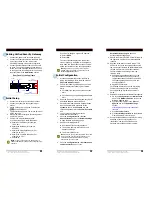
9
Chapter
157
High Availability
Overview
HA clusters
The
SEG
High
Availability
(HA)
feature
provides
hardware
redundancy
for
SEG
installations.
HA
works
by
adding
a
backup
slave
security
gateway
to
an
existing
master
security
gateway.
The
master
and
slave
are
connected
together
and
make
up
a
logical
HA
cluster
.
One
of
the
units
in
a
cluster
will
be
active
while
the
other
unit
is
inactive
and
on
standby.
The
master
and
slave
are
also
referred
to
as
cluster
nodes
or
cluster
peers
.
Initially,
the
cluster
slave
will
be
inactive
and
will
only
monitor
the
activity
of
the
master.
If
the
slave
detects
that
the
master
has
a
malfunction,
an
HA
failover
takes
place
and
the
slave
becomes
active,
assuming
processing
responsibility
for
all
traffic.
If
the
master
later
becomes
operative
again,
the
slave
will
continue
to
be
active
but
the
master
will
now
monitor
the
slave
with
a
failover
only
taking
place
if
the
slave
malfunctions.
This
is
sometimes
known
as
an
active
‐
passive
implementation.
Master and active units
When
reading
this
section
on
HA,
it
should
be
kept
in
mind
that
the
master
unit
in
a
cluster
is
not
always
the
same
as
the
active
unit
in
a
cluster.
The
active
unit
is
the
security
gateway
that
is
actually
processing
all
traffic
at
a
given
point
in
time.
This
could
be
the
slave
if
a
failover
has
occurred.
Interconnection of cluster peers
In
a
cluster,
the
master
and
slave
must
be
directly
connected
to
each
other
by
one
or
more
synchronization
connections
that
are
known
as
the
sync
interfaces.
One
or
more
of
the
interfaces
on
the
master
and
the
slave
can
be
dedicated
for
this
purpose
and
are
directly
connected
together
using
a
crossover
cable.
Although
this
connection
could
be
made
via
a
switch,
it
is
not
recommended.
The
primary
purpose
of
a
sync
interface
is
to
carry
state
synchronization
traffic
between
the
cluster
peers.
Sync
interfaces
must
not
be
used
for
normal
traffic.
Special
Ethernet
frames,
known
as
heartbeats
,
are
continually
sent
by
the
SEG
between
the
peers
in
the
cluster
across
the
sync
interfaces
and
any
other
interfaces
marked
as
critical
.
These
frames
allow
the
health
of
both
units
to
be
monitored.
Heartbeats
are
sent
in
both
directions
so
that
the
passive
unit
knows
about
the
health
of
the
active
unit
and
the
active
unit
knows
about
the
health
of
the
passive.
















































